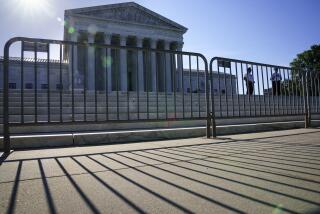High Courts Are a Too-Easy Target : We, the People, Must Defend Their Insulation From Politics
- Share via
Not since Franklin D. Roosevelt’s 1937 effort to have Congress expand the Supreme Court’s membership so that he could “pack” it with new appointees has judicial independence come under such intensive attack as today.
The insulation of courts from majority pressures is a vital element in maintaining the delicate balance of our constitutional system--a system in which the courts have the difficult and thankless job of ensuring the constitutional rights of criminal defendants and minorities, the elements least likely to find protection from the executive and legislative branches. Elected and appointed officials, at both state and federal levels, therefore have traditionally been expected to exercise some self-restraint in criticizing judges and courts.
Today, both in national debate in Washington and in places closer to the grass roots, those old expectations and norms are fading and bid fair to disappear.
The current crisis is not without precedent. Besides F.D.R.’s court-packing effort, there was the notorious “impeach Earl Warren” campaign led by racist elements in the 1950s and ‘60s and the equally vitriolic campaign of the last decade directed against the California Supreme Court.
Still, the rules of the game seem to have changed. The biggest change is in messages that originate from the White House and the Justice Department. Never in living memory have the highest federal offices routinely produced, as they do today, gloves-off, brass-knuckle public denunciations of the “liberal judiciary” generally and of specific court decisions.
The President’s unremitting criticism was reflected in proposals during his first term for legislation to reduce the jurisdiction of the court. At the same time, the Administration went to court to protect tax exemptions for schools that openly engaged in racial discrimination, to turn back affirmative-action rules and the like.
These efforts were only partly successful. Where Justice Department lawyers met full defeat in the courts, as when they tried to radically alter eligibility standards for Social Security disability benefits, the Administration stonewalled. Legal tactics used by the government lawyers to resist court decisions were so blatant that some were threatened with contempt citations.
Most lately, in the kind of statement that would have got someone fired forthwith in past administrations, Asst. Atty. Gen. William Bradford Reynolds delivered a vituperative personal attack on Justice William J. Brennan Jr.
It seems that extremism in the defense of neo-conservative ideology is OK.
This kind of poison seeps down through the whole national political system. The Administration’s court attacks have expanded the boundaries of what is viewed as “acceptable” rhetoric and behavior in California politics during the present election year, which finds six of seven state Supreme Court justices on the ballot for voter confirmation or rejection.
The justices’ names appear for a yes or no vote on their confirmation because of a 1934 amendment to the state Constitution that, ironically enough, was principally designed to take politics out of judgeship appointments and to strengthen the independence of the state judiciary. The 1934 change provided for nominations to the high court by the governor, approval by a special judicial commission and then submission of the judges’ names to voters for confirmation at the next general election.
Each of the seven seats on the court was established as a 12-year term, with the framers of the amendment expecting staggered and infrequent elections. The people would have a chance to vote for or against justices “on their record.” If a sea-change occurred in public opinion and political philosophy, it would affect the court only gradually, over several elections, if at all.
But history’s accidents have intervened. Because of a pattern of retirements and deaths, voters this fall will decide on all but one of the incumbent justices.
For Gov. George Deukmejian and other politicians, it was a brass ring that they could not resist grabbing as the political carrousel turned. The anti-court campaign is in full gear, and, if reelected, the governor may have a chance to reconstruct the court on ideological lines that will please him and the assembled special interests that have fueled a multimillion-dollar anti-court attack.
And so “court-packing” is again an issue--and again a threat to judicial independence. Only this time with a difference. As an alternative to enlarging the court, Roosevelt and his top aides considered proposing a change in procedure that would require a 7-2 vote to find laws or executive acts unconstitutional. Yet they rejected it for fear that it would undermine the efficacy of the court as a protector of minority rights and constitutional procedural guarantees.
One will listen in vain for any echoes of such concerns in today’s campaign against Chief Justice Rose Elizabeth Bird and her colleagues. Instead, we are treated to the worst sort of demagogic politics--”single-issue” style, with abundant distortion and brazenly malicious intent, especially regarding the highly emotional issue of the death penalty.
There are many “mainstream” California politicians, and many thinkers and doers of substance who on reasoned ground have gone along with the campaign against the state court. But why are they silent on the tactics? Why apparently unwilling to dissociate themselves from demagoguery?
More to Read
Get the L.A. Times Politics newsletter
Deeply reported insights into legislation, politics and policy from Sacramento, Washington and beyond. In your inbox three times per week.
You may occasionally receive promotional content from the Los Angeles Times.










